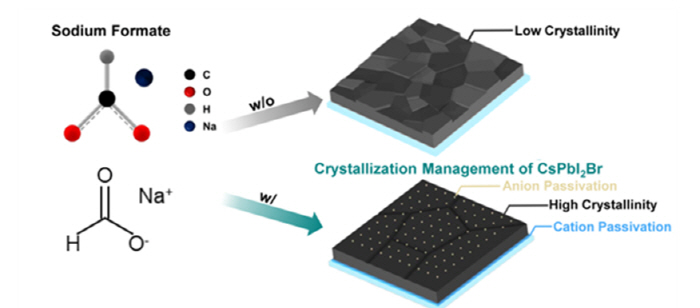Korea University: Technology for Fabricating High-Performance Inorganic Halide Perovskite Solar cells
Professor Noh Jun-hong’s group of the School of Civil Environmental and Architectural Engineering at the College of Engineering developed a crystallization management technology that can drastically improve the efficiency and stability of inorganic-material-based halide perovskite solar cells. The research group controlled the crystallization of a purely inorganic halide perovskite without organic constituents and achieved the highest fill factor among cesium (Cs)-based inorganic perovskite solar cells, preparing the way for the fabrication of future high-performance inorganic perovskite solar cells. The results of the research were published in Advanced Energy Materials (IF: 29.698), a renowned international journal in the field of energy, on May 1, 2023.
The research group developed a crystallization control technology that is effective in improving the efficiency and stability of Cs-based inorganic perovskite solar cells by introducing a novel alkali-based additive. The researchers induced a chemical interaction between the inorganic perovskite and the additive to control the rate of the crystallization of the inorganic perovskite. Furthermore, the research group investigated the effect of the alkaline ions and pseudo-halide ions of the novel additive on the defects of the inorganic perovskite within the thin film and on the interface, showing that the alkaline ions and pseudo-halide ions play an important role in improving the efficiency and stability of inorganic perovskite solar cells. The research group overcame an obstacle to the commercialization of perovskite solar cells by securing the long-term stability of inorganic perovskite solar cells through the use of a hole transport layer free of hygroscopic dopant. In addition, the research group produced a high-performance perovskite solar cell that exhibited the world’s highest fill factor.
The research results, particularly that the new CsPbI2Br-based inorganic perovskite solar cell fabrication method achieved a ground-breaking fill factor through crystallization control, were published in the renowned international journal Advanced Energy Materials.
So far, the research on perovskite solar cells has focused on the introduction of an organic and inorganic composite to an absorber layer, but organic and inorganic composite perovskite materials are vulnerable to heat. Inorganic-based perovskite solar cells have shown better thermal stability than organic and inorganic composite perovskite materials, and their wide bandgap allows their application to tandem solar cells. Therefore, studies have been actively conducted on Cs-based inorganic perovskite materials. Among the various Cs-based inorganic perovskite compositions, the CsPbI2Br perovskite composition has good phase stability compared to the CsPbI3 composition and exhibits semiconductor characteristics suitable for the top cells of triple-junction tandem solar cells.
However, the efficiency of CsPbI2Br-based perovskite solar cells is far from the theoretical limit, and they have previously been fabricated using a hole transport layer containing a hygroscopic dopant that lowers their stability. The hygroscopic dopant added to the hole transport layer absorbs moisture from the air and rapidly changes the phase of the lower inorganic perovskite, thereby reducing the long-term stability of solar cell devices.
To produce inorganic perovskite solar cells that satisfy both the high efficiency and high stability requirements, the research group developed a crystallization management technology that can effectively improve the crystallinity of inorganic perovskite. A novel additive (sodium formate) was introduced to the perovskite thin film to induce a chemical interaction with the perovskite and control the crystallization rate, thereby improving the uniformity of the thin film and increasing crystallinity. The researchers confirmed that the alkaline ions and pseudo-halide ions of the additive passivate the defects both within the inorganic perovskite thin film and at the interface, significantly decreasing the defect concentration in the device. The device fabricated by applying the crystallization management technology exhibited lower nonradiative recombination loss than the reference devices, so the overall performance of the solar cells was greatly enhanced.
Furthermore, the research group used a hole transport layer free of hygroscopic dopant to secure the long-term stability of the inorganic perovskite solar cells and produced a high-performance inorganic perovskite solar cell that featured the highest fill factor among CsPbI2Br-based perovskite solar cells.
Professor Noh said, “Our results are significant because we solved the phase stability issues of conventional inorganic perovskite solar cells and fabricated a CsPbI2Br inorganic perovskite solar cell featuring the world’s highest fill factor. Based on the results, we will be able to contribute to the development of ultrahigh-efficiency triple-junction solar cell technology using CsPbI2Br perovskite.”
The research was supported by the Energy Human Resources Fostering Program (Organic-Inorganic Composite Solar Cell Energy Innovation Research Center) of the Korea Institute of Energy Technology Evaluation and Planning (KETEP) from the Ministry of Trade, Industry, and Energy, the Midcareer Researcher Grant and the Phased Carbon Neutrality Technology Program of the Ministry of Science and ICT and the National Research Foundation of Korea (NRF), , and the Korea Electric Power Corporation.

